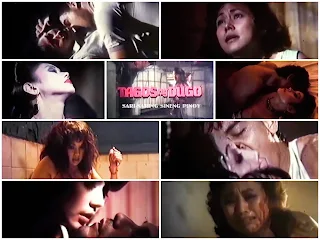This genial, celebratory interview with Filipino filmmaker Lino Brocka interspersed with movie clips hits a note of excitable cinephilia throughout. Christian Blackwood examines the hows and whys behind Brocka's oeuvre in Signed: Lino Brocka (Christian Blackwood Productions, 1987) and what makes him worthy of serious attention. Blackwood decided to interview the director in person and let him discuss his filmography on screen with no other talking heads. This gives us Brocka’s unfiltered point of view. The director’s candid commentary reveals him to be a filmmaker who made movies and finds the right combination of style and substance. At least we now know why he did what he did. Nevertheless, Blackwood remains a cinema aficionado delivering a simple interview-style retrospective of Brocka’s life and career. What’s important here is movies – movies and yet more movies. Brocka’s personal life is given the occasional sidelong glance and there is an extraordinary moment when he confesses his coming out story. A staggering revelation that is mentioned briefly. There are no critics or film historians on hand to testify or tear down Brocka’s movies. None of his stars or screenwriters are interviewed to pay tribute. The entire interview was shot with Blackwood remaining off-camera, as this rather straightforward and linear account of Brocka proceeds with brief cutaways to his subject’s body of work. The documentary races a little too breezily through the earliest years of Brocka’s movie obsession. Whether he’s remarking on Eddie Garcia's over the top performance in Tubog sa Ginto (1971), his stories are fascinating, sometimes providing new insight into a film, showcasing the director’s unexpected honesty about his work.
Perhaps the most interesting aspects of Signed: Lino Brocka involve his discussions about censorship and the Marcoses. If there’s a worthy criticism about Brocka, it’s that the documentary does not thoroughly investigate how he’s been perceived. It’s a fascinating career overview (backed by ample clips, of course), as he talks about his critical breakout with 1974's Tinimbang Ka Ngunit Kulang, his commercial success and box office failures. Blackwood puts Brocka in front of the camera and allows him to talk frankly and in depth about his journey through the Philippine movie industry. He explains single shots that bring the viewer into the moment while revealing an ever-changing perspective. What makes Signed: Lino Brocka an exciting and instructive film in its own right is that its subject is able to analyze his films from an emotional remove. That’s not to say he isn’t proud of what he made or that he’s overly self-critical. But he’s very rational with regard to what they are and what they achieved. The interesting thing is that he has insights on how every creative decision was made. Of course, not every movie Brocka made was great, but we emerge with a profound understanding of a singularly talented, creative filmmaker who invested himself fully in everything he did and whose work merits a second look. It becomes clear that nothing in his cinema is left to chance. The film’s focus on the work of its subject and desire to learn more from it is what really makes it worth watching. Signed: Lino Brocka is an entertaining portrait of a filmmaker that changed a generation.
Produced and Directed By: Christian Blackwood
Cinematography: Christian Blackwood
Editor: Monika Abspacher
Music: Michael Riesman
Sound: John Murphy








